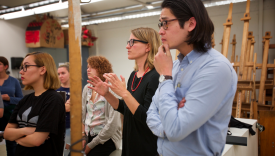Architectural Studies 203 - Cityscapes
(Offered as ARCH 203 and EUST 203.) Cities, the largest human artifact, have been at the center of Europeans’ relationships with nature, gods, and their own kind since their first appearance. With the advent of capitalist energy, the European city went through radical change. The resultant invention, re-invention and growth of major metropolises will be the subject of this course.
We will discuss histories and theories of the city and of the urban imagination in Europe since the eighteenth century. We will consider Paris, London, Berlin, Rome, and St. Petersburg, among others, and the counter-example of New York City. We will study examples of city planning and mapping, urban architecture, film and photography, painting, poetry, fiction, and urban theory. And, we may study Atget, Baudelaire, Benjamin, Calvino, Dickens, Joyce, Rilke, Truffaut, Zola, and others.
Questions addressed will include: To what extent do those who would “improve” a city take into account the intangible qualities of that city? How do the economics of capital compromise with the economics of living? How does the body-healthy and unhealthy-interact with the built environment? How and why does the imagination create an “invisible city” that rivals the “real” geo-political site? Two classes per week.
Limited to 25 students. Fall semester. Professor Rosbottom.


